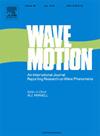On the viscoelastic-electromagnetic-gravitational analogy
IF 2.1
3区 物理与天体物理
Q2 ACOUSTICS
引用次数: 0
Abstract
The analogy between electromagnetism and gravitation was achieved by linearizing the tensorial gravitational equations of general relativity and converting them into a vector form corresponding to Maxwell’s electromagnetic equations. On this basis, we use the equivalence with viscoelasticity and propose a theory of gravitational waves. We add a damping term to the differential equations, which is equivalent to Ohm’s law in electromagnetism and Maxwell’s viscosity in viscoelasticity, to describe the attenuation of the waves. The differential equations in viscoelasticity are those of cross-plane shear waves, commonly referred to as SH waves. A plane-wave analysis gives the phase velocity, the energy velocity, the quality factor and the attenuation factor of the field as well as the energy balance. To obtain these properties, we use the analogy with viscoelasticity; the properties of electromagnetic and gravitational waves are similar to those of shear waves. The presence of attenuation means that the transient field is generally a composition of inhomogeneous (non-uniform) plane waves, where the propagation and attenuation vectors do not point in the same direction and the phase velocity vector and the energy flux (energy velocity) are not collinear. The polarization of cross-plane field is linear and perpendicular to the propagation-attenuation plane, while the polarization of the field within the plane is elliptical. Transient wave fields in the space–time domain are analyzed with the Green function (in homogeneous media) and with a grid method (in heterogeneous media) based on the Fourier pseudospectral method for calculating the spatial derivatives and a Runge–Kutta scheme of order 4 for the time stepping. In the examples, wave propagation at the Sun–Earth and Earth–Moon distances using quadrupole sources is considered in comparison to viscoelastic waves. The Green and grid solutions are compared to test the latter algorithm. Finally, an example of propagation in heterogeneous media is presented.
关于粘弹性-电磁-引力类比
通过将广义相对论的张量引力方程线性化,并将其转换为与麦克斯韦电磁方程相对应的矢量形式,实现了电磁学与引力之间的类比。在此基础上,我们利用与粘弹性的等价关系,提出了引力波理论。我们在微分方程中加入了一个阻尼项,相当于电磁学中的欧姆定律和粘弹性中的麦克斯韦粘度,用来描述波的衰减。粘弹性中的微分方程是跨平面剪切波的微分方程,通常称为 SH 波。平面波分析给出了相速度、能量速度、场的品质因数和衰减系数以及能量平衡。为了获得这些特性,我们使用了粘弹性的类比方法;电磁波和引力波的特性与剪切波相似。衰减的存在意味着瞬态场通常由不均匀(非均匀)平面波组成,其中传播矢量和衰减矢量不指向同一方向,相位速度矢量和能量通量(能量速度)也不平行。跨平面场的极化是线性的,垂直于传播-衰减平面,而平面内场的极化是椭圆形的。分析时空域中的瞬态波场时,使用了格林函数(在均质介质中)和网格法(在异质介质中),网格法基于计算空间导数的傅立叶伪谱法和计算时间步进的 4 阶 Runge-Kutta 方案。在示例中,考虑了使用四极源在太阳-地球和地球-月球距离上的波传播,并与粘弹性波进行了比较。比较了格林解法和网格解法,以测试后一种算法。最后,介绍了一个在异质介质中传播的例子。
本文章由计算机程序翻译,如有差异,请以英文原文为准。
求助全文
约1分钟内获得全文
求助全文
来源期刊

Wave Motion
物理-力学
CiteScore
4.10
自引率
8.30%
发文量
118
审稿时长
3 months
期刊介绍:
Wave Motion is devoted to the cross fertilization of ideas, and to stimulating interaction between workers in various research areas in which wave propagation phenomena play a dominant role. The description and analysis of wave propagation phenomena provides a unifying thread connecting diverse areas of engineering and the physical sciences such as acoustics, optics, geophysics, seismology, electromagnetic theory, solid and fluid mechanics.
The journal publishes papers on analytical, numerical and experimental methods. Papers that address fundamentally new topics in wave phenomena or develop wave propagation methods for solving direct and inverse problems are of interest to the journal.
 求助内容:
求助内容: 应助结果提醒方式:
应助结果提醒方式:


